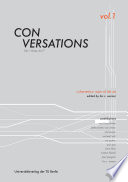Product desciption
Cybernetics State Of The Art Werner Liss C by Werner, Liss C. 9783798329539, 3798329532 instant download after payment.
CYBERNETICS: STATE OF THE ART is the first volume of the book series CON-VERSATIONS. Driven by cybernetic thinking, it engages with pressing questions for architecture, urban planning, design and automated infrastructure; in an age of increasing connectivity, AI and robotization and an evolutionary state of the Anthropocene - perpetuating angst-ridden anxiety as well as excitement and joy of a future, that we will be able to predict with less and less certainty. The book, with a foreword by Omar Khan, discusses cybernetic principles and devices developed in the late 20th century – mainly developed by Ross Ashby and Gordon Pask (second-order cybernetics), to learn from for a future of mutual relationship and conversation between man and machine. The anthology reviews and previews cybernetics as design strategy in computational architecture, urban design and socio-ecological habitats - natural and artificial. It weaves together cybernetic-architectural theories with applications and case studies ranging from regional planning to the smart home. Nine chapters written by an international group of authors from four academic generations are structured into two complimenting parts. While ‘A Concept and a Shape’ focuses on the history and theory of cybernetics, its temporary disappearance and future impact (Raúl Espejo, Michael Hohl, Paul Pangaro, Liss C. Werner), ‘System 5’ – relating to Stafford Beer’s project ‘Cybersyn’ - discusses applications, the role of the individual and human feedback; also with a strong theoretical underpinning (Raoul Bunschoten, Delfina Fantini van Ditmar, Timothy Jachna, Arun Jain, Kristian Kloeckl). CYBERNETICS: STATE OF THE ART invites the reader to enjoy a glimpse into the past to enjoy and discuss a cybernetic future. CYBERNETICS: STATE OF THE ART mit einem Vorwort von Omar Khan ist die erste Buchausgabe der Serie CON-VERSATIONS. Auf kybernetisches Denken und Schaffen basierend, diskutiert CON-VERSATIONS Fragen zu Architektur, Stadtplanung, Gestaltungsstrategien und automatisierter Infrastruktur in einer evolutionär zunehmenden Vernetzung durch künstliche Intelligenz, Robotisierung; im Zeitalter der Anthropozän, in einem Zustand der sich verewigenden angstbeherrschten Unruhe - wie auch einer besonderen Lust auf eine Zukunft, die wir mit immer weniger Sicherheit voraussagen können. Das Konzept ‚Kybernetik zweiter Ordnung’ des späten 20igsten Jahrhunderts, u.a. entwickelt von Ross Ashby und Gordon Pask, begründet das Buch. Es genießt einen Rückblick und eine Vorschau in eine kybernetische Zukunft der gemeinsamen kausalen Beziehung zwischen Mensch und Maschine. Die Autoren schlagen Kybernetik als Entwurfsstrategie für computer-generierte/-gestützte Architektur, Stadtplanung und natürlich und künstliche sozio-ökologische Lebensumwelten vor. Das Buch kombiniert kybernetisch-architektonische Theorie mit Fallstudien reichend von Regionalplanung zu ‚Smart Home’. Neun Kapitel, geschrieben von einer internationalen Autorenschaft aus vier akademischen Generationen, sind in zwei sich ergänzende Buchteile strukturiert. ‘A Concept and a Shape’, mit Kapiteln von Raúl Espejo, Michael Hohl, Paul Pangaro, Liss C. Werner, diskutiert Geschichte und Wissenschaft der Kybernetik sowie ihr temporäres Verschwinden und Einfluss auf die Zukunft. ‚System 5’ (in Anlehnung an Stafford Beer’s Projekt ‚Cybersyn’) mit Kapiteln von Raoul Bunschoten, Delfina Fantini van Ditmar, Timothy Jachna, Arun Jain, Kristian Kloeckl, beschreibt kybernetische Praxis, die Rolle des Individuums und ‚Human Feedback’ - ebenfalls mit einem starken theoretischen Fundament. CYBERNETICS: STATE OF THE ART lädt den Leser ein, einen aufschlussreichen Blick in die Vergangenheit zu werfen, um eine kybernetische Zukunft zu genießen und zu diskutieren.


